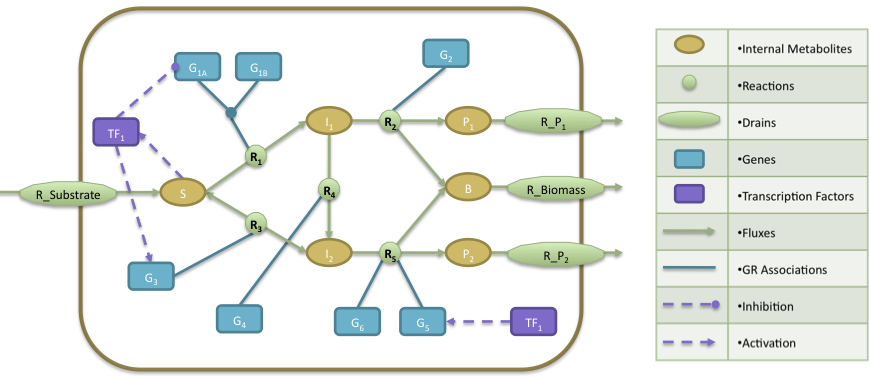From Optflux
(Created page with "__TOC__ =Example file= You can download it here -> IntegratedModelToy.zip") |
|||
| Line 4: | Line 4: | ||
You can download it here -> [[Media:IntegratedModelToy.zip|IntegratedModelToy.zip]] | You can download it here -> [[Media:IntegratedModelToy.zip|IntegratedModelToy.zip]] | ||
| + | |||
| + | [[Image:IntegratedModel.png]] | ||
| + | |||
| + | This tutorial uses this example based on an example from '''J. Kim and J. Reed'''.''OptORF: Optimal metabolic and regulatory perturbations for metabolic engineering of microbial strains''. BMC, 2010 | ||
| + | |||
| + | |||
| + | *The regulatory model is composed by a transcription factor (TF1) that is activated when metabolite S is present, activates the expression of two genes (G3, G5) and represses the expression of gene G1A. | ||
| + | |||
| + | *The Gene Reactions rules said us that: R1 is catalyzed when the gene G1A and G1B are activated; R2 is catalyzed by the gene G2; R3 and R4 are catalyzed by the genes G3 and G4, respectively; finally, R5 can be catalyzed by either genes G5 or G6. | ||
| + | |||
| + | *In the metabolic level, the substrate (S) is utilized to produce biomass (B) and by-products P1 and P2. The cellular objective is to maximize biomass production (B) and the engineering objective is the production of P1. Reaction R2 converts the internal metabolite I1 into product P1 and 0.08 biomass (B), whereas reaction R5 converts the internal metabolite I2 into product P2 and 0.12 Biomass. The stoichiometric coefficients of all other reactions reflect a one-to-one relationship between molecule quantities. | ||
Revision as of 11:16, 10 September 2013
Contents
Example file
You can download it here -> IntegratedModelToy.zip
This tutorial uses this example based on an example from J. Kim and J. Reed.OptORF: Optimal metabolic and regulatory perturbations for metabolic engineering of microbial strains. BMC, 2010
- The regulatory model is composed by a transcription factor (TF1) that is activated when metabolite S is present, activates the expression of two genes (G3, G5) and represses the expression of gene G1A.
- The Gene Reactions rules said us that: R1 is catalyzed when the gene G1A and G1B are activated; R2 is catalyzed by the gene G2; R3 and R4 are catalyzed by the genes G3 and G4, respectively; finally, R5 can be catalyzed by either genes G5 or G6.
- In the metabolic level, the substrate (S) is utilized to produce biomass (B) and by-products P1 and P2. The cellular objective is to maximize biomass production (B) and the engineering objective is the production of P1. Reaction R2 converts the internal metabolite I1 into product P1 and 0.08 biomass (B), whereas reaction R5 converts the internal metabolite I2 into product P2 and 0.12 Biomass. The stoichiometric coefficients of all other reactions reflect a one-to-one relationship between molecule quantities.
